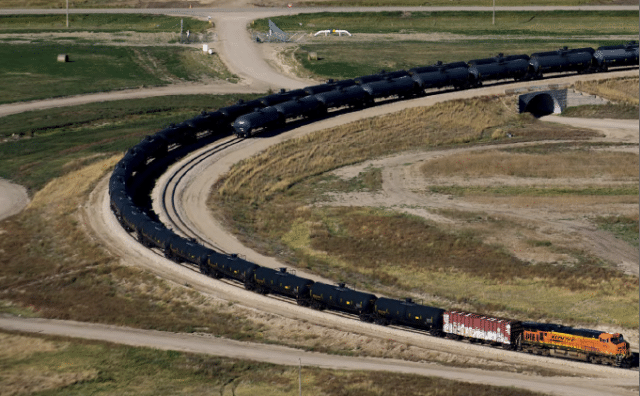Last December, the first full train carrying tar sands crude left the Canexus Bruderheim terminal outside of Edmonton, Alberta, bound for an unloading terminal somewhere in the United States.
Canadian heavy crude, as the tar sands is labeled for market purposes, had ridden the rails in very limited capacity in years previous — loaded into tank cars and bundled with other products as part of so-called “manifest” shipments. But to the best of industry analysts’ knowledge, never before had a full 100-plus car train (called a “unit train”) been shipped entirely full of tar sands crude.
Because unit trains travel more quickly, carry higher volumes of crude and cost the shipper less per barrel to operate than the manifest alternative, this first shipment from the Canexus Bruderheim terminal signaled the start of yet another crude-by-rail era — an echo of the sudden rise of oil train transport ushered in by the Bakken boom, on a much smaller scale (for now).
This overall spike in North American crude-by-rail over the past few years has been well documented, and last month Oil Change International released a comprehensive report about the trend. As explained in Runaway Train: The Reckless Expansion of Crude-by-Rail in North America (and in past coverage in DeSmogBlog), much of the oil train growth has been driven by the Bakken shale oil boom. Without sufficient pipeline capacity in the area, drillers have been loading up much more versatile trains to cart the light, sweet tight crude to refineries in the Gulf, and on both coasts.
Unfortunately, some of these “bomb trains” never make it to their destination, derailing, spilling, exploding and taking lives.
While shale oil, predominantly from the Bakken, has driven the trend, Canadian tar sands producers are increasingly turning their attention to rail. Hobbled by limited pipeline capacity out of Alberta, and frustrated by their inability (so far) to ram the Keystone XL pipeline through the American heartland, tar sands producers are signing contracts with Canadian rail operators. Canadian National Railway is getting the lionshare of the business.
Canadian National not only has the infrastructure in place near Alberta’s tar sands developments, but also operates 19 subsidiary railways in the United States under the Grand Trunk Corporation. Strung together, Canadian National network stretches 2,800 miles from Western Canada down to the Gulf Coast, the only company that can offer straight-through shipping from the tar sands to Gulf Coast refineries.
Of the upstream infrastructure — or the loading terminals up near the tar sands, the Oil Change International report explains:
At the time of writing there were 31 terminals in operation that load tar sands or heavy crude, with six of these expanding and an additional eight planned or under construction…
The first terminal designed to load unit trains with Canadian tar sands crude, the Canexus terminal in Bruderheim, northeast of Edmonton, Alberta, started operations in December 2013. It has a capacity of 70,000 bpd and loads tar sands bitumen from MEG’s Christina Lake SAGD project, among others.
Downstream, rail terminals are similarly adapting to handle shipments of tar sands crude. From the Runaway Train report:
Terminals designed to unload tar sands crude are currently concentrated in the Gulf Coast region, where the biggest concentration of heavy oil refining capacity is located…
The Gulf Coast terminals have about one million bpd of unloading capacity today, set to grow to over two million bpd in 2016. Some of this capacity is at refineries such as those operated by Valero in Port Arthur, Texas, and St. Charles, Louisiana. Valero has ordered 1,600 insulated and coiled tank cars specifically for hauling tar sands crude to its refineries.
The Gulf Coast also has significant midstream capacity on the Mississippi River, where crude oil, including tar sands crude, is unloaded from trains and pumped from storage tanks into local pipelines or loaded onto barges that deliver to coastal refineries via the Intracoastal Waterway.
Meanwhile, refineries on the Atlantic and Pacific coasts are angling to get in on the action, hoping that their shipping advantages to Europe and Asia respectively will prove appealing to tar sands producers.
As described in Runaway Train, terminals on the West Coast are particularly well positioned to serve as a “fast-track out of North America for Canada’s tar sands.”
There are currently 13 crude-by-rail unloading terminals in California, Oregon and Washington, of which four are currently expanding their capacity. There are also 11 terminals planned or under construction.
Many of these are at refineries that, like their counterparts on the East Coast, are looking to take advantage of discounted domestic or Canadian crudes that they have little hope of ever gaining access to via pipeline. With a larger proportion of refining capacity geared up for heavy tar sands processing than exists on the East Coast, West Coast refineries such as the Valero facility in Wilmington, Calif., and the Phillips 66 refineries in California and Washington, are keen to rail in tar sands crude.
Accessing these West Coast refineries by rail, as well as the prospect of export terminals in Washington and Oregon, are potentially the tar sands industry’s best bet for major market expansion in the face of delays and possible cancellation of the Keystone XL pipeline and pipelines to the Canadian west coast such as the Northern Gateway and Trans Mountain expansion.
These latter projects, which are primarily focused on exporting tar sands crude to Asia, face particularly stiff opposition from coastal communities, which fear the destruction of fisheries and coastal environments from the increased tanker traffic that would ensue.
Given the relative proximity particularly of Washington State refineries and ports to Alberta’s tar sands fields, these terminals offer oil companies a potential solution to the transportation bottlenecks that are threatening the viability of tar sands production growth. At least three proposals in southern Washington State have the potential to unload tar sands crude from trains and load it onto tankers for export to Asia or transport to refineries along the California coast.
Tar sands producers are particularly motivated to get their crude to coastal terminals and refineries for export. As we’ve covered in the past on DeSmogBlog, tar sands companies want to export their product, because the low-grade crude is more easily refined into diesel, which has a much larger market in Europe and Asia. This is the core reason that the Keystone XL, if built, would be little more than an export pipeline, and wouldn’t actually provide more oil to American markets, nor lower American gas and heating oil prices.
The Oil Change International report also shines a light on the fact that though crude exports are banned from the U.S., domestic refineries can legally export crude from Canada.
While crude oil of U.S. origin is subject to export restrictions, no such restriction applies to exports of Canadian oil through the U.S., as long as it can be shown that no U.S. oil was blended.
Shippers wishing to export Canadian oil from U.S. ports still have to apply for export licenses from the Department of Commerce, but these can and have been granted. Given the lack of pipeline capacity to Canadian ports, it is attractive for tar sands producers to find ways to get their product to a U.S. port where it can be exported. Crude-by-rail terminals on the West and East Coasts are strategically important as they are closer to Alberta than those on the Gulf Coast and it is therefore cheaper to reach these ports by rail.
Railbit vs. Dilbit
As this still-nascent segment of crude-by-rail develops, it’s worthwhile to take a moment to understand the distinction between a couple of different tar sands products that are being shipped by train. The vast majority of tar sand crude-by-rail shipments thus far have been diluted bitumen, or dilbit. Dilbit, which you have heard of as the tar sands crude that is already funneling through North American pipelines, is composed of the sticky, viscous tar sands bitumen, which is then mixed with about 30 percent diluent, allowing it to flow through pipelines. This mixture of dilbit is particularly volatile and abrasive, and reports have pointed to it being more likely to cause leaks and spills and explosions during transport.
Railbit is a relatively new designation for crude, and is defined as bitumen that has been mix with roughly 17 percent diluent. Moving railbit, rather than dilbit, saves tar sands shippers about half of the so-called “diluent penalty,” or the cost of adding the diluent to the mix.
So why are most trains still loaded with dilbit? Because to this point, most loading terminals are still being fed by feeder pipelines or trucks that can only handle this more watered down blend. That and the fact that special loading and unloading facilities are necessary to handle railbit, which is more viscous and needs to be heated in special tank cars to be unloaded. Some downstream terminals are making these investments, seeing railbit as a viable alternative going forward, but today dilbit is still dominant.
Either way, it’s dirty and dangerous, and tar sands bitumen in any form does nothing to lower American energy bills. Bitumen, by rail or pipeline or barge, is bound to wind up on a tanker to Europe or Asia.
Subscribe to our newsletter
Stay up to date with DeSmog news and alerts






